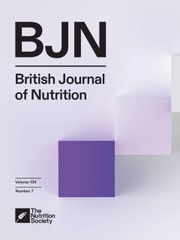Crossref Citations
This article has been cited by the following publications. This list is generated based on data provided by
Crossref.
Jacobson, G A
Tong, Y C
Townsend, A T
Featherstone, A M
Ball, M
Robertson, I K
and
Peterson, G M
2007.
Selenium status in Southern Tasmania.
European Journal of Clinical Nutrition,
Vol. 61,
Issue. 9,
p.
1057.
Sanchez-Villegas, Almudena
Henríquez, Patricia
Figueiras, Adolfo
Ortuño, Felipe
Lahortiga, Francisca
and
Martínez-González, Miguel A.
2007.
Long chain omega-3 fatty acids intake, fish consumption and mental disorders in the SUN cohort study.
European Journal of Nutrition,
Vol. 46,
Issue. 6,
p.
337.
Johnson, Natalie C.
Manchester, Shawn
Sarin, Love
Gao, Yuming
Kulaots, Indrek
and
Hurt, Robert H.
2008.
Mercury Vapor Release from Broken Compact Fluorescent Lamps and In Situ Capture by New Nanomaterial Sorbents.
Environmental Science & Technology,
Vol. 42,
Issue. 15,
p.
5772.
Taylor, Andrew
Branch, Simon
Day, Martin P.
Patriarca, Marina
and
White, Mark
2008.
Atomic spectrometry update. Clinical and biological materials, foods and beverages.
Journal of Analytical Atomic Spectrometry,
Vol. 23,
Issue. 4,
p.
595.
Rayman, Margaret P.
Infante, Heidi Goenaga
and
Sargent, Mike
2008.
Food-chain selenium and human health: spotlight on speciation.
British Journal of Nutrition,
Vol. 100,
Issue. 2,
p.
238.
Wilson, R. T.
Wang, J.
Chinchilli, V.
Richie, J. P.
Virtamo, J.
Moore, L. E.
and
Albanes, D.
2009.
Fish, Vitamin D, and Flavonoids in Relation to Renal Cell Cancer Among Smokers.
American Journal of Epidemiology,
Vol. 170,
Issue. 6,
p.
717.
Sakamoto, Mineshi
Murata, Katsuyuki
Kubota, Machi
Nakai, Kunihiko
and
Satoh, Hiroshi
2010.
Mercury and heavy metal profiles of maternal and umbilical cord RBCs in Japanese population.
Ecotoxicology and Environmental Safety,
Vol. 73,
Issue. 1,
p.
1.
Poudel-Tandukar, Kalpana
Nanri, Akiko
Iwasaki, Motoki
Mizoue, Tetsuya
Matsushita, Yumi
Takahashi, Yoshihiko
Noda, Mitsuhiko
Inoue, Manami
and
Tsugane, Shoichiro
2011.
Long chain n-3 fatty acids intake, fish consumption and suicide in a cohort of Japanese men and women — The Japan Public Health Center-based (JPHC) Prospective Study.
Journal of Affective Disorders,
Vol. 129,
Issue. 1-3,
p.
282.
MURATA, Katsuyuki
YOSHIDA, Minoru
SAKAMOTO, Mineshi
IWAI-SHIMADA, Miyuki
YAGINUMA-SAKURAI, Kozue
TATSUTA, Nozomi
IWATA, Toyoto
KARITA, Kanae
and
NAKAI, Kunihiko
2011.
Recent Evidence from Epidemiological Studies on Methylmercury Toxicity.
Nippon Eiseigaku Zasshi (Japanese Journal of Hygiene),
Vol. 66,
Issue. 4,
p.
682.
Burger, Joanna
and
Gochfeld, Michael
2013.
Selenium/mercury molar ratios in freshwater, marine, and commercial fish from the USA: variation, risk, and health management.
Reviews on Environmental Health,
Vol. 28,
Issue. 2-3,
Bai, Hong-wei
Qian, Ye-yong
Shi, Bing-yi
Li, Gang
Fan, Yu
Wang, Zhen
Yuan, Ming
Liu, Lu-peng
and
Scott, Rodney John
2013.
The Association between Fish Consumption and Risk of Renal Cancer: A Meta-Analysis of Observational Studies.
PLoS ONE,
Vol. 8,
Issue. 11,
p.
e81939.
Han, Sung
2014.
Nutrition-Infection Interactions and Impacts on Human Health.
p.
357.
Kim, Byung-Mi
Choi, Anna L.
Ha, Eun-Hee
Pedersen, Lise
Nielsen, Flemming
Weihe, Pal
Hong, Yun-Chul
Budtz-Jørgensen, Esben
and
Grandjean, Philippe
2014.
Effect of hemoglobin adjustment on the precision of mercury concentrations in maternal and cord blood.
Environmental Research,
Vol. 132,
Issue. ,
p.
407.
Gil, Angel
and
Gil, Fernando
2015.
Fish, a Mediterranean source ofn-3 PUFA: benefits do not justify limiting consumption.
British Journal of Nutrition,
Vol. 113,
Issue. S2,
p.
S58.
Ser, Ping Han
Omi, Sanae
Shimizu-Furusawa, Hana
Yasutake, Akira
Sakamoto, Mineshi
Hachiya, Noriyuki
Konishi, Shoko
Nakamura, Masaaki
and
Watanabe, Chiho
2017.
Differences in the responses of three plasma selenium-containing proteins in relation to methylmercury-exposure through consumption of fish/whales.
Toxicology Letters,
Vol. 267,
Issue. ,
p.
53.
Dack, Kyle
Huang, Peiyuan
Taylor, Caroline M
Rai, Dheeraj
and
Lewis, Sarah J
2024.
Environmental and genetic predictors of whole blood mercury and selenium concentrations in pregnant women in a UK birth cohort.
Environmental Advances,
Vol. 15,
Issue. ,
p.
100469.




